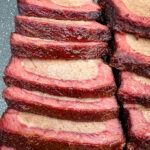
Traeger Smoked Brisket
This Traeger Smoked Brisket is seasoned with a homemade BBQ rub and served tender and juicy with the perfect smoke ring. This recipe works for any smoker or pellet grill.
Servings 6 servings
Calories 456kcal
Ingredients
- beef brisket Any sized brisket will work for this recipe.
- ½-1 cup BBQ or pork rub Use enough spices to fully coat the meat.
- salt and pepper to taste
- 2 tablespoons melted butter Measured solid.
- 1-2 tablespoons apple cider vinegar.
- butcher paper or foil
Instructions
- Trim any excess fat along the top of the meat of the brisket. I like to keep the cap of fat on the brisket. I do not trim it because it helps add flavor to the beef.
- If necessary, separate the point from the flat. Illustrative details can be found here.
- Fully coat the brisket with the rub, salt, and pepper to taste. Place the brisket in the fridge to absorb the flavor of the spices. Minimum 30 minutes, but a few hours to overnight is best.
- Preheat smoker to 175 degrees. I typically cook it overnight and start at 175 degrees to avoid overcooking it. You can also smoke it at 225 degrees.
- Add the brisket to the smoker, fat side down. Smoke until it reaches an internal temperature of 175 degrees.
- Remove the brisket from the smoker and drizzle it in the butter and apple cider vinegar. Wrap it tightly in butcher paper or foil. Be sure it's tight so that the moisture is locked in.
- Add the wrapped brisket to the smoker at 250 degrees fat side up. This will allow the fat from the brisket to seep into the beef as it smokes. Cook until it reaches an internal temperature of 203-205 degrees.
- Remove the brisket and allow the brisket to rest inside the wrap for at least 30 minutes. I allowed it to rest for over an hour before unwrapping and slicing.
Notes
-
My favorite pellets for brisket are hickory and mesquite. Oak, cherry, maple, and apple will also work well along with the Traeger Signature blend.
- Electric and gas smokers cook at consistent temperatures which makes it easier to predict cooking time per pound than for pit or barrel smokers. Keeping the lid closed contains heat and shortens the cooking time. If you’re consistently checking in this will increase the cook time.
- Other cook time factors include the thickness and grade of the meat, the amount of fat, and the weather conditions. On a cold, windy evening, a brisket can take more than two hours per pound to cook. A higher grade of brisket that has more marbling and fat usually will cook more quickly than a lower grade.
- Butcher paper is more breathable and traps less steam. This will help keep the brisket moist without making the bark (top coating) soggy.
- Foil-wrapped brisket will cook faster than butcher paper-wrapped. Wrapping in foil will capture the fat from the juices of the meat which is reabsorbed and creates juicy brisket. Because it creates an overly moist environment, this typically results in soggy bark (the coating at the top).
- Tough brisket is usually the result of undercooking, cooking it at too high of a temperature, or not wrapping it so it dried out.
Nutrition
Serving: 0.5pound | Calories: 456kcal | Carbohydrates: 2g | Protein: 55g | Fat: 24g